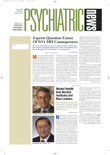Firefighters have been found especially at risk for posttraumatic stress disorder, and ballet dancers for eating disorders. So could persons pursuing a career in art or design be predisposed to an obsession with flaws in their appearance—that is, to body dysmorphic disorder?
The notion sounds outrageous. And yet: Some British investigators have found a novel link between a career in art or design and the disorder.
It all started when David Veale, M.D., a consultant psychiatrist and senior lecturer at the University of London, noted that many patients with body dysmorphic disorder seemed to be preoccupied with art or design. For instance, they may have been educated in fine art, art history, or architecture or graphics, fashion, or textile design; or they may have pursued occupations in one of these areas. He thus wondered whether people with body dysmorphic disorder would be more likely to have an education in art or design or a career in art or design than people with other types of psychiatric conditions.
Veale and his colleagues collected information on occupation and higher education or training from the case notes of 100 consecutive patients with body dysmorphic disorder and compared the same information for 100 patients with a major depressive episode, 100 with obsessive-compulsive disorder, and 100 with posttraumatic stress disorder. All study participants were outpatients in a private psychiatric hospital, the Priory Hospital North London, from 1996 on.
Indeed, as the researchers reported in the October American Journal of Psychiatry, their findings confirmed their hypothesis. Twenty percent of patients with body dysmorphic disorder had an occupation or education in art or design, compared with 4 percent of patients with a major depressive episode, 3 percent of those with obsessive-compulsive disorder, and none with posttraumatic stress disorder. All of these differences were highly statistically significant.
“Our findings reveal a possible association between body dysmorphic disorder and an interest in art or design,” Veale and his colleagues concluded in their study report, and “to our knowledge, no occupational or educational association has been identified previously in patients with body dysmorphic disorder.”
Katharine Phillips, M.D., an associate professor of psychiatry at Brown University School of Medicine and an authority on body dysmorphic disorder, commented on the study. She said that in her clinical work with such patients, she had not been struck by any particular link between an interest in art or design and the disorder. She also pointed out that the study had some limitations.
For example, it consisted of a retrospective review of case notes with the potential problem of missing data. The data were based on self-report without confirmation by interviewers. The researchers used DSM criteria rather than a diagnostic interview schedule to make a diagnosis of body dysmorphic disorder. The investigators also failed to mention how many raters there were or whether they had assessed interrater reliability in determining whether someone was an artist. Also, it is unclear whether the raters were blind to the study hypothesis.
“If you are blind to the study hypothesis, it allows you to make a more objective appraisal of your data, especially if you were collecting retrospectively from case notes,” Phillips said.
Nonetheless, “having said all that, because no study is perfect,” Phillips continued, “it is an innovative study with intriguing results, and it raises very interesting questions about body dysmorphic disorder that no one has looked at before.”
For instance, Veale and his coworkers suggested in their study report that because persons who pursue education or a career in art or design have a keen interest in aesthetics, it might be that passion that leads them to become obsessed with supposed flaws in their own appearance.
“This is a provocative and interesting and possibly accurate statement,” Phillips said.
Yet even if it is true, she continued, it does not explain a very perplexing phenomenon that she has often observed in patients with this disorder. Instead of concentrating on obvious appearance flaws in themselves, or at least what most people would consider imperfections, they are haunted instead by very minor details of their appearance. So rather than having higher aesthetic standards than most people, they may have different aesthetic standards, she speculated.
Still another possibility, Veale and his coworkers suggested, is that it may not be a passion for aesthetics that drives certain people to body dysmorphic disorder, but rather the disorder might lead certain individuals with it to become enthralled with aesthetics.
What is needed at this point, Veale and his coworkers believe, is a larger and better-designed study. It would not just attempt to confirm that there is truly a link between an interest in art or design and body dysmorphic disorder, but also unmask which comes first—the interest or the ailment.
Veale and his colleagues plan to attempt such a study depending on the outcome of a grant application.
Am J Psychiatry 2002 159 1788
